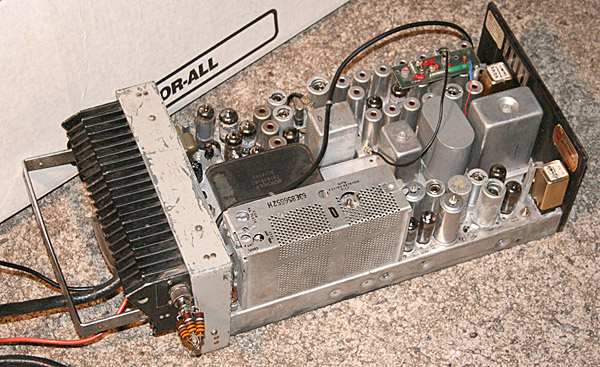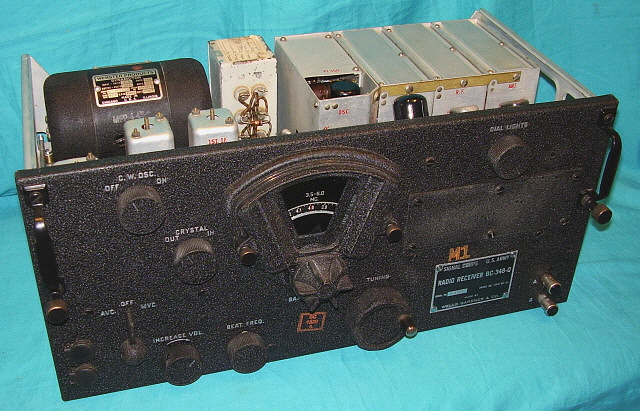fixing am radio?
Weirdest radios I've run across were the ones made for 1 or 2 years by GM, maybe others, which used "low voltage" B+ tubes.
Now the order of progress is like so:
In the early days, and up until real close to transistors, "tubes" had to have high voltage to provide the anode (plate) and screen, and in older designs, even bias voltages. So you had "A" for filament, "B" for anode/ screen, and "C" for bias. At first these were provided by batteries,
(advanced "tech," at the time:)

but in autos, later provided by the lovely VIBRATOR power supply. This is a chopper device used to provide "pseudo" AC so that a transformer would operate and step up voltage.
The guts of some vibrators. Basically a buzzer which opened and closed separate contacts as the thing vibrated back and forth

A simple vibrator supply. Not all used vacuum tube rectifiers. Some were what is called "synchronous" which means they had two identical sets of contacts. As the primary contacts chopped up DC into "AC" for the transformer primary, the second set acted as rectifiers to "dechop" the "AC" output back to pulsing DC, then to be filtered. arcing. sparking. noisy. not reliable in today's parlance

THEN we developed "vibrator substitutes" which were transistor choppers to replace the vibrators for the high voltage, but still using "tubes" in the rest of the radio. These were used extensively in stuff like Motorola and GE "police" and other commercial radios
Old Motorola "T" power: The heat sink on the front is for the power supply transistors, the center chassis. The chassis nearest you is the transmitter strip, the shield at the left/ front being for RF power output stages. Just about everything in this radio is tubes except the T power unit.

In still higher power two way sets, sometimes a LOVELY device called a "dynamotor" is used. A "dynamo" is what people used to call what amount to a generator. A "dynamotor" is a "dynamo" and a motor constructed on the same armature. You feed this "black box" low voltage at high current, such as 6, 12, 24V, and out comes high voltage. In some cases VERY high voltage!!!
A BC-348 communications receiver, used is such stuff as B-17s and many other aircraft. The dynamotor, the black thing in the rear, was fed 28VDC and produced the B+ and other tube operating voltages

At about the same time, GM (maybe others) came up with a car radio based on special "tubes." These tubes require no high voltage for the tube anodes, operating right off the car's 12V power. However, the low voltage tubes cannot produce enough power to operate an audio output stage, so these radios would have one big power transistor for the audio output.
Low B+ tubes:
http://www.junkbox.com/electronics/lowvoltagetubes.shtml
Weirdest radios I've run across were the ones made for 1 or 2 years by GM, maybe others, which used "low voltage" B+ tubes.
Now the order of progress is like so:
In the early days, and up until real close to transistors, "tubes" had to have high voltage to provide the anode (plate) and screen, and in older designs, even bias voltages. So you had "A" for filament, "B" for anode/ screen, and "C" for bias. At first these were provided by batteries,
(advanced "tech," at the time:)

but in autos, later provided by the lovely VIBRATOR power supply. This is a chopper device used to provide "pseudo" AC so that a transformer would operate and step up voltage.
The guts of some vibrators. Basically a buzzer which opened and closed separate contacts as the thing vibrated back and forth
A simple vibrator supply. Not all used vacuum tube rectifiers. Some were what is called "synchronous" which means they had two identical sets of contacts. As the primary contacts chopped up DC into "AC" for the transformer primary, the second set acted as rectifiers to "dechop" the "AC" output back to pulsing DC, then to be filtered. arcing. sparking. noisy. not reliable in today's parlance

THEN we developed "vibrator substitutes" which were transistor choppers to replace the vibrators for the high voltage, but still using "tubes" in the rest of the radio. These were used extensively in stuff like Motorola and GE "police" and other commercial radios
Old Motorola "T" power: The heat sink on the front is for the power supply transistors, the center chassis. The chassis nearest you is the transmitter strip, the shield at the left/ front being for RF power output stages. Just about everything in this radio is tubes except the T power unit.

In still higher power two way sets, sometimes a LOVELY device called a "dynamotor" is used. A "dynamo" is what people used to call what amount to a generator. A "dynamotor" is a "dynamo" and a motor constructed on the same armature. You feed this "black box" low voltage at high current, such as 6, 12, 24V, and out comes high voltage. In some cases VERY high voltage!!!
A BC-348 communications receiver, used is such stuff as B-17s and many other aircraft. The dynamotor, the black thing in the rear, was fed 28VDC and produced the B+ and other tube operating voltages

At about the same time, GM (maybe others) came up with a car radio based on special "tubes." These tubes require no high voltage for the tube anodes, operating right off the car's 12V power. However, the low voltage tubes cannot produce enough power to operate an audio output stage, so these radios would have one big power transistor for the audio output.
Low B+ tubes:
http://www.junkbox.com/electronics/lowvoltagetubes.shtml